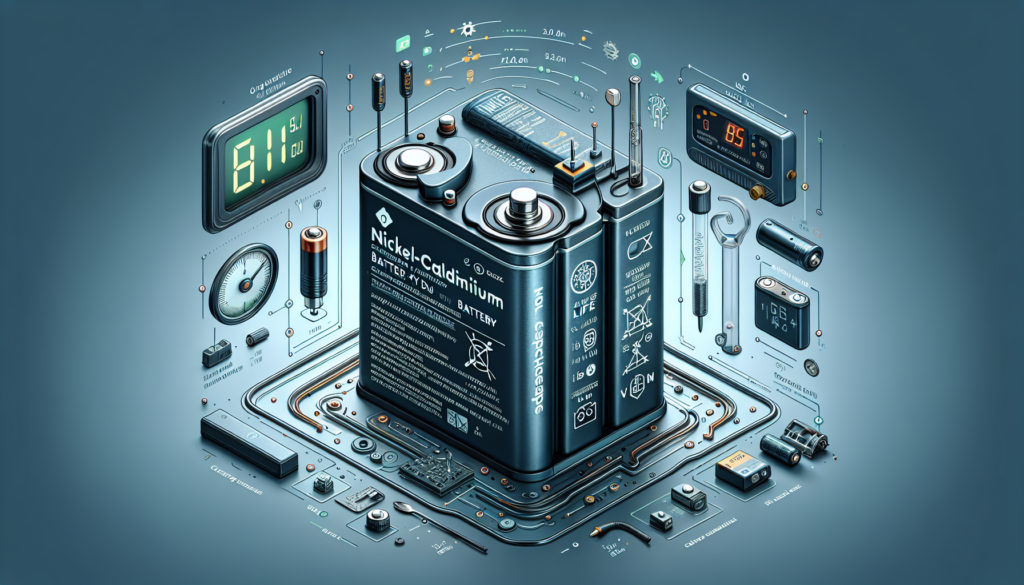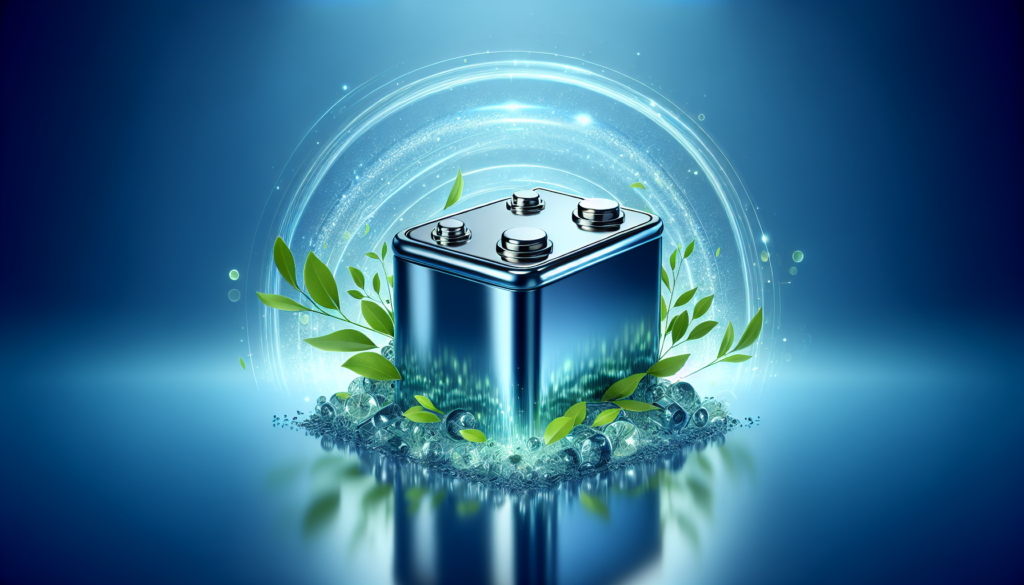Nickel-Cadmium (NiCd) batteries – a reliable and versatile power source that has been around for decades. With their high energy density and ability to deliver a steady current, NiCd batteries have found their way into countless applications, from portable electronics to power tools. In this article, we will explore the key features and advantages of NiCd batteries, as well as some important considerations for their use and maintenance. So, whether you are a gadget enthusiast or a professional in need of a reliable power solution, join us as we uncover the secrets of Nickel-Cadmium batteries.
Overview
What are Nickel-Cadmium Batteries?
Nickel-Cadmium (NiCd) batteries are a type of rechargeable battery that use a nickel oxide hydroxide and metallic cadmium as the active materials. These batteries have been widely used for many decades due to their durability, reliability, and versatility. They are commonly found in various applications ranging from electronics to power tools and medical devices.
Advantages of Nickel-Cadmium Batteries
There are several advantages to using nickel-cadmium batteries. One of the key advantages is their long cycle life, which means they can be charged and discharged many times before losing their capacity. NiCd batteries also have a high tolerance for overcharging and deep discharging, making them more forgiving and easier to use. Additionally, they have a relatively constant voltage output throughout their discharge cycle, providing a stable power supply for electronic devices.
Disadvantages of Nickel-Cadmium Batteries
While nickel-cadmium batteries have many benefits, they also have some limitations. One major drawback is their relatively low energy density compared to other battery types, such as lithium-ion batteries. This means that NiCd batteries tend to be bulkier and heavier for the same amount of energy storage. Another disadvantage is the memory effect, which can occur if the batteries are not fully discharged before recharging. This memory effect can lead to a reduction in overall capacity over time if not properly managed.
Chemistry
Electrochemical Reactions
The operation of a nickel-cadmium battery involves electrochemical reactions between the active materials within the battery. During discharge, the nickel hydroxide reacts with the cadmium to form nickel oxide, while the cadmium is converted into cadmium hydroxide. The reverse reaction occurs during charging, where the nickel oxide and cadmium hydroxide are converted back into nickel hydroxide and cadmium. These reactions result in the flow of electrons, generating an electrical current that can be utilized to power various devices.
Construction of a NiCd Battery
A nickel-cadmium battery typically consists of several key components. The positive electrode, or the cathode, is made of nickel hydroxide mixed with a conductive material, such as graphite. The negative electrode, or the anode, is composed of metallic cadmium. These electrodes are separated by a separator, which allows the movement of ions while preventing electrical short circuits. The electrolyte, usually potassium hydroxide solution, completes the circuit and facilitates the ionic flow between the electrodes.
Working Principle
Charge Cycling
The working principle of a nickel-cadmium battery involves a process called charge cycling. This involves charging the battery to its full capacity and then discharging it completely before recharging again. This cycle ensures that the battery maintains its capacity and prevents the memory effect from occurring. It is important to follow these charge cycling guidelines to maximize the lifespan and performance of NiCd batteries.
Self-Discharge
One characteristic of nickel-cadmium batteries is self-discharge. This means that even when not in use, NiCd batteries gradually lose their charge over time. The rate of self-discharge varies depending on the battery’s age and environmental conditions. To mitigate self-discharge, it is recommended to recharge NiCd batteries regularly to ensure they are ready for use when needed.
Memory Effect
The memory effect is a phenomenon wherein a battery’s capacity is reduced if it is repeatedly recharged without being fully discharged. This effect is more pronounced in nickel-cadmium batteries compared to other battery types. To prevent or minimize the memory effect, it is essential to fully discharge NiCd batteries before recharging them. This practice helps maintain the battery’s capacity and overall performance.

Applications
Electronics
Nickel-cadmium batteries have been widely used in various electronic devices, such as portable radios, flashlights, and remote controls. Their stable voltage output and long cycle life make them suitable for powering low-drain devices over an extended period. However, their relatively low energy density limits their application in high-power electronics compared to newer battery technologies.
Power Tools
One significant application of nickel-cadmium batteries is in power tools. NiCd batteries have been a popular choice for cordless drills, saws, and other power tools due to their high discharge rates and durability. They can provide sufficient power for demanding tasks and withstand the demands of frequent recharging and discharging during intensive use on construction sites or workshops.
Emergency Lighting
Another common application of nickel-cadmium batteries is emergency lighting systems. NiCd batteries are often used as backup power sources in exit signs and emergency lighting fixtures. Their long cycle life and low self-discharge rate ensure they are ready to provide light during power outages or emergencies.
Medical Devices
Nickel-cadmium batteries are also extensively used in medical devices such as pacemakers, defibrillators, and hearing aids. Their reliability, long shelf life, and ability to deliver consistent power make them well-suited for critical healthcare applications. Additionally, NiCd batteries can withstand extreme temperatures, making them suitable for use in medical devices that require a wide operating range.
Maintenance
Use and Discharge Guidelines
To maximize the lifespan and performance of nickel-cadmium batteries, it is essential to follow proper use and discharge guidelines. It is recommended to fully discharge the battery before recharging to prevent the memory effect. Avoid overcharging the battery, as it can lead to decreased capacity and potential damage. It is also advisable to avoid deep discharges, as they can cause irreversible damage to the battery.
Storage Recommendations
When storing nickel-cadmium batteries, it is crucial to keep them in a cool and dry environment. Extreme temperatures can affect the battery’s performance and lead to degradation. It is advisable to store the batteries in a partially discharged state, around 30-40% of their full capacity. Regularly check and recharge stored batteries to prevent self-discharge and ensure they are in optimal condition when needed.
Cleaning and Maintenance
Regular cleaning and maintenance can prolong the lifespan of nickel-cadmium batteries. Ensure that the battery contacts and terminals are clean and free from dirt, corrosion, or other contaminants. Use a soft cloth or a cotton swab with a mild cleaning solution, such as alcohol, to clean the battery surfaces. It is important to handle the batteries with care and avoid dropping or exposing them to excessive physical stress.
Safety Considerations
Toxicity and Environmental Impact
One significant safety consideration with nickel-cadmium batteries is their toxicity and potential environmental impact. Cadmium, a heavy metal used in these batteries, is a hazardous substance and can pose risks to human health and the environment if not handled and disposed of properly. When dealing with NiCd batteries, it is essential to follow local regulations for safe handling, recycling, and disposal to minimize environmental contamination.
Safe Handling and Disposal
To safely handle nickel-cadmium batteries, it is recommended to wear gloves and eye protection when handling them, especially if they are damaged or leaking. Avoid direct skin contact or inhalation of any fumes or dust that may be released from the batteries. When disposing of NiCd batteries, it is important to recycle them through proper recycling facilities that can recover the valuable materials and dispose of any hazardous components.
Comparison with Other Battery Types
Nickel-Metal Hydride (NiMH) Batteries
NiCd batteries are often compared to nickel-metal hydride (NiMH) batteries due to their similar chemistry. NiMH batteries are an improvement over NiCd batteries in terms of energy density and reduced toxicity. They offer a higher energy storage capacity while being more environmentally friendly. However, NiCd batteries still excel in certain applications requiring high discharge rates, extreme temperature tolerance, or long shelf life.
Lithium-Ion (Li-ion) Batteries
Lithium-ion (Li-ion) batteries have gained significant popularity in recent years due to their high energy density and lightweight design. Compared to nickel-cadmium batteries, Li-ion batteries offer even higher energy storage capacity, faster charging times, and reduced self-discharge. They have become the preferred choice for many portable electronic devices, electric vehicles, and renewable energy storage systems. However, Li-ion batteries are more sensitive to overcharging and require sophisticated protection circuits to ensure safe operation.
Future Outlook
Advancements in NiCd Battery Technology
Despite the emergence of newer battery technologies, research and development in nickel-cadmium battery technology continue to make progress. Efforts are being made to improve their energy density and reduce the memory effect. However, the environmental concerns associated with cadmium content have led to stricter regulations and a shift towards alternative battery types.
Alternatives to NiCd Batteries
Due to their environmental impact, nickel-cadmium batteries are being gradually replaced by more sustainable alternatives. Nickel-metal hydride (NiMH) batteries are commonly used as a direct replacement for NiCd batteries in many applications. Lithium-ion (Li-ion) batteries, although more expensive, are becoming increasingly popular due to their high energy density and improved safety features. Additionally, research is ongoing to develop new battery chemistries, such as solid-state batteries, which could potentially replace NiCd batteries in the future.
Conclusion
Nickel-cadmium batteries have been a reliable and versatile power source for various applications. Their long cycle life, stable voltage output, and resilience to overcharging and deep discharging make them a popular choice. However, their relatively low energy density and environmental concerns have led to the emergence of alternative battery technologies. As technology progresses, it is expected that newer battery types will continue to replace nickel-cadmium batteries in many applications. Nevertheless, NiCd batteries will continue to serve a niche role in industries that require high discharge rates, extreme temperature tolerance, and extended shelf life.

